| September 26, 2007 |  |
our time will build eternity |
| Previous Issues | Sep 25 | Sep 24 | Sep 21 | Sep 20 | Sep 19 |
NASA, NSBRI Select 17 Proposals In Space Radiation Research Washington DC (SPX) Sep 26, 2007
Washington DC (SPX) Sep 26, 2007The crews of future missions to the moon and Mars could face serious health risks from exposure to space radiation. NASA and the National Space Biomedical Research Institute, known as NSBRI, Houston, will fund 17 new research projects that will enable NASA to better understand and reduce those risks. Scientists at universities, research institutions and private companies in eight states will c ... more Tracing Martian Water  Moffett Field CA (SPX) Sep 26, 2007
Moffett Field CA (SPX) Sep 26, 2007NASA's Mars Reconnaissance Orbiter (MRO) is examining several features on Mars that address the role of water at different times in Martian history. Liquid water is essential for life as we know it, and determining the history of water on Mars is vital in understanding whether or not the planet could have supported life in its past. Studying locations where water may have flowed and pooled on th ... more MIT Tether Could Aid Asteroid Missions  Boston MA (SPX) Sep 26, 2007
Boston MA (SPX) Sep 26, 2007Using a tether system devised by MIT researchers, astronauts could one day stroll across the surface of small asteroids, collecting samples and otherwise exploring these rocks in space without floating away. The ability to visit asteroids could also be invaluable for testing equipment for a mission to Mars by humans. Further, knowing how to tether an asteroid could be helpful if one needs to be ... more MIT Observations Give Precise Estimate Of Mars Surface Ice  Boston MA (SPX) Sep 26, 2007
Boston MA (SPX) Sep 26, 2007An MIT-led team of planetary scientists has found that the southern pole of Mars contains the largest deposit of frozen water in the inner solar system, outside of Earth. The new results show that water, not carbon dioxide, is the predominant frozen liquid found in the southern polar region of Mars, said Maria Zuber, MIT professor of geophysics. Zuber said scientists have suspected that th ... more Mars Gully: No Mineral Trace Of Liquid Water  Pasadena CA (SPX) Sep 25, 2007
Pasadena CA (SPX) Sep 25, 2007This image of the Centauri-Hellas Montes region was taken by the Compact Reconnaissance Imaging Spectrometer for Mars (CRISM) at 2107 UTC (4:07 p.m. EST) on Jan. 9, 2007, near 38.41 degrees south latitude, 96.81 degrees east longitude. CRISM's image was taken in 544 colors covering 0.36-3.92 micrometers, and shows features as small as 20 meters (66 feet) across. The region covered is slightly wi ... more |
mars-base
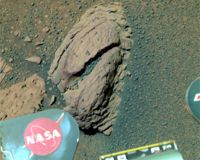 spacetravel 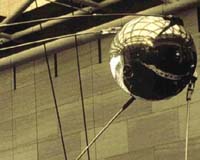 mars-water 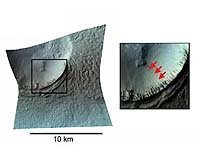 |
 Pasadena CA (SPX) Sep 24, 2007
Pasadena CA (SPX) Sep 24, 2007NASA's Mars Odyssey spacecraft has discovered entrances to seven possible caves on the slopes of a Martian volcano. The find is fueling interest in potential underground habitats and sparking searches for caverns elsewhere on the Red Planet. Very dark, nearly circular features ranging in diameter from about 100 to 250 meters (328 to 820 feet) puzzled researchers who found them in images taken by ... more Argon Provides Atmospheric Clues  Troy NY (SPX) Sep 24, 2007
Troy NY (SPX) Sep 24, 2007Geochemists at Rensselaer Polytechnic Institute are challenging commonly held ideas about how gases are expelled from the Earth. Their theory, which is described in the Sept. 20 issue of the journal Nature, could change the way scientists view the formation of Earth's atmosphere and those of our distant neighbors, Mars and Venus. Their data throw into doubt the timing and mechanism of atmospheri ... more Global space summit looks to the future, 50 years after Sputnik-1  Hyderabad, India (AFP) Sept 21, 2007
Hyderabad, India (AFP) Sept 21, 2007Fifty years after the launch of the first man-made satellite, the global space industry gathers in India next week to find ways to benefit humanity -- and make money in the process. Missions to the moon and Mars, the completion of an international space station and efforts to ward off earth-threatening asteroids and natural disasters through space technology will top the agenda. Multi-bi ... more Shaking Off The Dust And Getting Back To Work  Pasadena CA (JPL) Sep 21, 2007
Pasadena CA (JPL) Sep 21, 2007The skies continue to clear over the Opportunity site, and the dust is falling from both the sky and the rover. The last week was dedicated to evaluating the payload and assessing dust accumulation on the instruments. Fortunately, the solar array energy has improved to over 350 Watt-hours for the last four sols. This has given the vehicle enough power to support two alpha particle X-ray spectr ... more |
mars-water
 mars-life  mars-odyssey 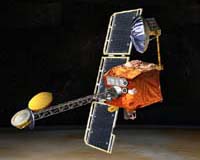 |
 Pasadean CA (JPL) Sep 19, 2007
Pasadean CA (JPL) Sep 19, 2007In early June 2007, the Mars Science Laboratory project completed its project-wide Critical Design Review (CDR), which marks the completion of the project's design phase and transition into the build up of flight hardware. A key component of the CDR process was a technical risk, programmatic, and cost review, from which multiple independent cost assessments predicted that this technically ... more The UA Is Over The Moon About Mars  Tuscon AZ (SPX) Sep 18, 2007
Tuscon AZ (SPX) Sep 18, 2007The Phoenix Mars Mission is on its way to the Red Planet after a flawless launch from Cape Canaveral in early August. With landing scheduled for late May 2008, it might seem like there is nothing to do but wait through a long nine months. But The University of Arizona won't be idle during the cruise phase. Mission scientists are diligently preparing for landing and science operations. And the ... more Mice and men: space gerbils blaze trail for humans to Mars  Moscow (AFP) Sept 14, 2007
Moscow (AFP) Sept 14, 2007Ten gerbils took off from the Russian-run Baikonur space centre in Kazakhstan on Friday for a 12-day voyage to test the possible effects of a human mission to Mars, an official said Friday. A Foton-M spaceship with the rodents on board took off on a Soyuz rocket, mission official Anfisa Kazakova told AFP by telephone. The rocket is to include a cage with 10 rodents with the aim of ... more New Theory Explains Ice On Mars  Honolulu HI (SPX) Sep 14, 2007
Honolulu HI (SPX) Sep 14, 2007Wobbles on Mars cause ice ages that are much more dramatic than those on Earth, says astronomer Norbert Schorghofer of the University of Hawaii. Thanks to our large, stabilizing Moon, Earth's rotation axis is always tilted by about 23 degrees. The tilt of Mars, however, can wobble by as much as 10 degrees from its current 25 degrees. Wobbles cause big changes in the amount of sunlight reaching ... more
|
mars-mers
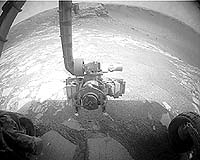 mars-mers 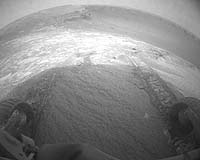 marsexpress 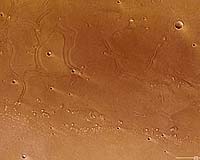 |
| Previous Issues | Sep 25 | Sep 24 | Sep 21 | Sep 20 | Sep 19 |
| The contents herein, unless otherwise known to be public domain, are Copyright 1995-2007 - SpaceDaily. AFP and UPI Wire Stories are copyright Agence France-Presse and United Press International. ESA Portal Reports are copyright European Space Agency. All NASA sourced material is public domain. Additional copyrights may apply in whole or part to other bona fide parties. Advertising does not imply endorsement, agreement or approval of any opinions, statements or information provided by SpaceDaily on any web page published or hosted by SpaceDaily. Privacy statement |